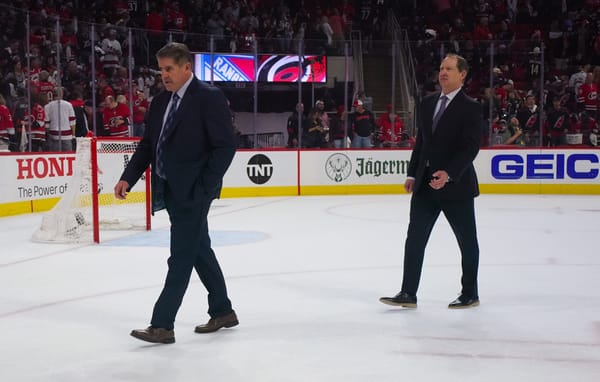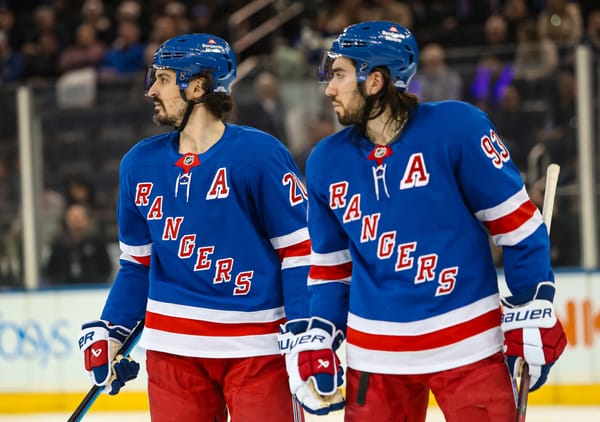Rangers vs. Blue Jackets preview: Even without Boyle, the power play is still in better shape
Many assume when the Rangers lost Dan Boyle the team took the biggest hit on the power play, but that's not the case.
Dan Boyle was, among other things, signed this offseason to help correct the Rangers power play issues. With a lack of puck movement, a lack of a big shot from the point, and a total lack of ability to carry the puck into the offensive zone to begin orchestrating the action, Boyle could check 'yes' in all of those regards with respect to his skill set.
But only 42:50 into Boyle's New York Rangers debut, the defenseman went down to block a shot, breaking his hand, and putting him on the shelf for the next 4-6 weeks.
The Rangers will unequivocally be hurt on the power play, but that won't be where this Boyle injury will hit the team the hardest, and in reality, the Rangers power play is still in a better position than it was last season.
The levels of anemia the Blueshirts power play reached last season were historic. After looking steadier coming out of the gate in the regular season sans former assistant and special teams maestro Mike Sullivan, the team regressed, or perhaps showed the early effectiveness it enjoyed was an aberration, falling out of the league's top 10, and finishing in 15th overall.
Those struggles not only carried into but completely bottomed-out in the postseason, where that aforementioned history was made, and the team went 36 straight power play without converting, setting an NHL record.
So how in the hell is the power play in an area one could consider "better shape" after losing its new, shiny man-advantage toy?
Personnel was what doomed the Rangers last season. Systemically, Scott Arniel, who replaced Sullivan, also replaced his static power play (really, New York's power play under Sullivan didn't stress player movement, bafflingly) with an actual, functioning scheme. Yet without the players to execute, the situation caught up to the Rangers, and the power play unit went into a big-time slide.
Gone is Brad Richards, who occupied one of the point spot opposite Ryan McDonagh on the top unit. Richards actually would have been much better suited playing off one of the half-walls, but, again, without a group with the diverse talents to fill each space, Richards and his not-strong-enough shot were pigeonholed onto the blue line.
When Boyle went down, and the Rangers went on a power play midway through the third period of the opener, Vigneault went with these five players: McDonagh, Lee Stempniak, Martin St. Louis, Chris Kreider, and Anthony Duclair.
Stempniak represented Boyle (and Richard's replacement), and is a player who actually has some experience playing the point on the power play. Duclair, however, represented a replacement for Derek Stepan, a player who many probably disregarded in losses on the power play because of how ineffective he was in these situations. Stepan, a willing-passer in 5v5 situations, made it no mystery he had no intentions of ever shooting the puck on the power play. His ability to setup his teammates was negated because he never looked to goal, and thus never forced penalty killers to get in his shooting lanes.
Duclair, however, showed in a very small sample size what he's capable of doing on the power play. On one play, he corralled the puck along the boards, stick handled to evade an oncoming penalty killer, and wired a pass to the point onto the tape of McDonagh.
Simply from a personnel standpoint, Stempnaik is an upgrade over Richards, and Duclair may be, at worst, a lateral replacement for Stepan. While a healthy Boyle may represent the best situation for the Rangers power play, losing their new signing doesn't represent the worst (that was last season, or really, the Sullivan-era Rangers power play).
What's amazing is, the Rangers ineptitude in that area of the game didn't hold them back last season. Amid that 0-for-36 streak in the playoffs, the Rangers defeated the Flyers, and began their comeback against the Penguins.
 More on the power play
More on the power play 
 More on the power play
More on the power play 
Defensively, while it more or less goes without saying, is where the Rangers will face their biggest challenge. For the time being, it appears Alain Vigneault has elected to bump up Kevin Klein into the second pairing along Marc Staal, and inserted Matt Hunwick on pairing three.
For all the praise that's been heaped on Klein, the catalyst of it all began with the initial realization that "he's not as bad as Michael Del Zotto." Heck, it wouldn't have been difficult for Klein to reach those heights, but here are some other facts about the 29-year-old defenseman: He's never been capable of driving possession, and even when joining a strong possession team in the Rangers last season, posted poor numbers. With a career CF% of 46.2, and a career CorsiRel of -3.6%, Klein is best-served playing sheltered minutes against weaker competition. Klein didn't post sparkling numbers in the Rangers opener against the Blues, but that may have been a factor of John Moore's really unsteady play.
In a span of one game, Staal has gone from playing alongside fancy stats darling Anton Stralman, to the very solid Boyle, to now Klein. Staal is used to having to carry his partner on his back, having played next to Dan Girardi for quite some time, but this move undoubtedly makes the Rangers a weaker defensive team. A pairing of Moore and Hunwick will really be tested, while Vigneault has consistently complimented Hunwick for his pace and how he can fit into the Rangers system.
For the Rangers, power play success, along with being an anomaly, has been something of a bonus. The team has managed pretty good success without it, while when it's been there, it's been a pleasant surprise. Losing Boyle on special teams creates no doomsday in that regard, while New York's next task will be navigating the next 4-6 without the defensive services of Boyle.




